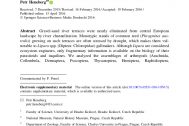Rok
2016Autoři
Mgr. Igor Malenovský, Ph.D.RNDr. Milan Řezáč, Ph.D.
Druhy
Singa nitidula C. L. Koch, 1844 LCObsah
Gravel-sand river terraces were nearly eliminated from central European landscape by river channelization. Monotypic stands of common reed (Phragmites australis) growing on such terraces are often stressed by drought, which makes them vulnerable to Lipara spp. (Diptera: Chloropidae) gallmakers. Although Lipara are considered ecosystem engineers, only fragmentary information is available on the biology of their parasitoids and inquilines. We analyzed the assemblages of arthropods (Arachnida, Collembola, Dermaptera, Psocoptera, Thysanoptera, Hemiptera, Raphidioptera, Neuroptera, Coleoptera, Diptera, Lepidoptera and Hymenoptera) that emerged from 17,791 Lipara-induced galls collected in winter from 30 reed beds in the Czech Republic, 15 of which were situated at (post)industrial sites (gravel-sandpits, tailing ponds, limestone quarries, colliery dumps, and reclaimed lignite open-cast mines) and 15 were in near-natural habitats (medieval fishponds, and river and stream floodplains). The Chao-1 estimator indicated 229.3 ± 18.1 species in reed galls at (post)industrial and 218.1 ± 23.6 species at near-natural sites, with the Sørensen index reaching only 0.58. We identified 18 red-listed species and four new species for the Czech Republic (Gasteruption phragmiticola, Echthrodelphax fairchildii, Haplogonatopus oratorius and Enclisis sp.), representing mostly obligate (64 %) or facultative (9 %) reed specialists. We propose that Lipara gall-associated assemblages undergo a long-term cyclic ecological succession. During first 10 years after reed bed formation, only Lipara spp. and several other species occur. During next decades, the reed beds host species-rich assemblages with numerous pioneer species (Singa nitidula, Polemochartus melas) that critically depend on presence of prior disturbances. Middle-aged reed beds (near medieval fishponds) are prevalently enriched in common species only (Oulema duftschmidi, Dimorphopterus spinolae). Habitats with the longest historical continuity (river floodplains) host again species-rich assemblages with several rare species that probably require long-term habitat continuity (Homalura tarsata, Hylaeus moricei). Landscape dynamics is thus critical for the persistence of a full spectrum of reed gall inquilines, with (post)industrials serving as the only refugia for pioneer species ousted from their key nesting habitats at once cyclically disturbed gravel-sand river terraces.



